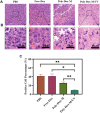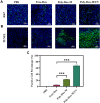Light-Responsive Micelles Loaded With Doxorubicin for Osteosarcoma Suppression
- PMID: 34220512
- PMCID: PMC8249570
- DOI: 10.3389/fphar.2021.679610
Light-Responsive Micelles Loaded With Doxorubicin for Osteosarcoma Suppression
Abstract
The enhancement of tumor targeting and cellular uptake of drugs are significant factors in maximizing anticancer therapy and minimizing the side effects of chemotherapeutic drugs. A key challenge remains to explore stimulus-responsive polymeric nanoparticles to achieve efficient drug delivery. In this study, doxorubicin conjugated polymer (Poly-Dox) with light-responsiveness was synthesized, which can self-assemble to form polymeric micelles (Poly-Dox-M) in water. As an inert structure, the polyethylene glycol (PEG) can shield the adsorption of protein and avoid becoming a protein crown in the blood circulation, improving the tumor targeting of drugs and reducing the cardiotoxicity of doxorubicin (Dox). Besides, after ultraviolet irradiation, the amide bond connecting Dox with PEG can be broken, which induced the responsive detachment of PEG and enhanced cellular uptake of Dox. Notably, the results of immunohistochemistry in vivo showed that Poly-Dox-M had no significant damage to normal organs. Meanwhile, they showed efficient tumor-suppressive effects. This nano-delivery system with the light-responsive feature might hold great promises for the targeted therapy for osteosarcoma.
Keywords: doxorubicin; light-responsive nanoparticles; micelles; osteosarcoma; targeted therapy.
Copyright © 2021 Chen, Qian, Ren, Yu, Kong, Huang, Luo and Chen.
Conflict of interest statement
The authors declare that the research was conducted in the absence of any commercial or financial relationships that could be construed as a potential conflict of interest.
Figures







Similar articles
-
Redox and pH dual responsive poly(amidoamine) dendrimer-poly(ethylene glycol) conjugates for intracellular delivery of doxorubicin.Acta Biomater. 2016 May;36:241-53. doi: 10.1016/j.actbio.2016.03.027. Epub 2016 Mar 16. Acta Biomater. 2016. PMID: 26995505
-
Poly(ethylene glycol) shell-sheddable TAT-modified core cross-linked nano-micelles: TAT-enhanced cellular uptake and lysosomal pH-triggered doxorubicin release.Colloids Surf B Biointerfaces. 2020 Apr;188:110772. doi: 10.1016/j.colsurfb.2020.110772. Epub 2020 Jan 20. Colloids Surf B Biointerfaces. 2020. PMID: 31999965
-
mPEGylated solanesol micelles as redox-responsive nanocarriers with synergistic anticancer effect.Acta Biomater. 2017 Dec;64:211-222. doi: 10.1016/j.actbio.2017.09.040. Epub 2017 Sep 27. Acta Biomater. 2017. PMID: 28963017
-
PEG-Detachable Polymeric Micelles Self-Assembled from Amphiphilic Copolymers for Tumor-Acidity-Triggered Drug Delivery and Controlled Release.ACS Appl Mater Interfaces. 2019 Feb 13;11(6):5701-5713. doi: 10.1021/acsami.8b13059. Epub 2019 Jan 29. ACS Appl Mater Interfaces. 2019. PMID: 30644711
-
Gold nanoparticles with a monolayer of doxorubicin-conjugated amphiphilic block copolymer for tumor-targeted drug delivery.Biomaterials. 2009 Oct;30(30):6065-75. doi: 10.1016/j.biomaterials.2009.07.048. Epub 2009 Aug 12. Biomaterials. 2009. PMID: 19674777
Cited by
-
Polymeric Micellar Systems-A Special Emphasis on "Smart" Drug Delivery.Pharmaceutics. 2023 Mar 17;15(3):976. doi: 10.3390/pharmaceutics15030976. Pharmaceutics. 2023. PMID: 36986837 Free PMC article. Review.
-
Natural Products for Preventing and Managing Anthracycline-Induced Cardiotoxicity: A Comprehensive Review.Cells. 2024 Jul 6;13(13):1151. doi: 10.3390/cells13131151. Cells. 2024. PMID: 38995002 Free PMC article. Review.
-
Advancements in Osteosarcoma Therapy: Overcoming Chemotherapy Resistance and Exploring Novel Pharmacological Strategies.Pharmaceuticals (Basel). 2025 Apr 3;18(4):520. doi: 10.3390/ph18040520. Pharmaceuticals (Basel). 2025. PMID: 40283955 Free PMC article. Review.
-
Research Progress on the Mechanism, Monitoring, and Prevention of Cardiac Injury Caused by Antineoplastic Drugs-Anthracyclines.Biology (Basel). 2024 Sep 3;13(9):689. doi: 10.3390/biology13090689. Biology (Basel). 2024. PMID: 39336116 Free PMC article. Review.
-
Nanosized drug delivery strategies in osteosarcoma chemotherapy.APL Bioeng. 2023 Feb 23;7(1):011501. doi: 10.1063/5.0137026. eCollection 2023 Mar. APL Bioeng. 2023. PMID: 36845905 Free PMC article. Review.
References
-
- Andreadis C., Gimotty P. A., Wahl P., Hammond R., Houldsworth J., Schuster S. J., et al. (2007). Members of the Glutathione and ABC-Transporter Families Are Associated with Clinical Outcome in Patients with Diffuse Large B-Cell Lymphoma. Blood 109 (8), 3409–3416. 10.1182/blood-2006-09-047621 - DOI - PMC - PubMed
-
- Berrino F., De Angelis R., Sant M., Rosso S., Bielska-Lasota M., Coebergh J. W., et al. (2007). Survival for Eight Major Cancers and All Cancers Combined for European Adults Diagnosed in 1995-99: Results of the EUROCARE-4 Study. Lancet Oncol. 8 (9), 773–783. 10.1016/S1470-2045(07)70245-0 - DOI - PubMed
LinkOut - more resources
Full Text Sources
Research Materials

